Woman's Medical College vs the 1918 Flu Pandemic
-by Ari McManus, Public History Virtual Intern Summer/Fall 2020
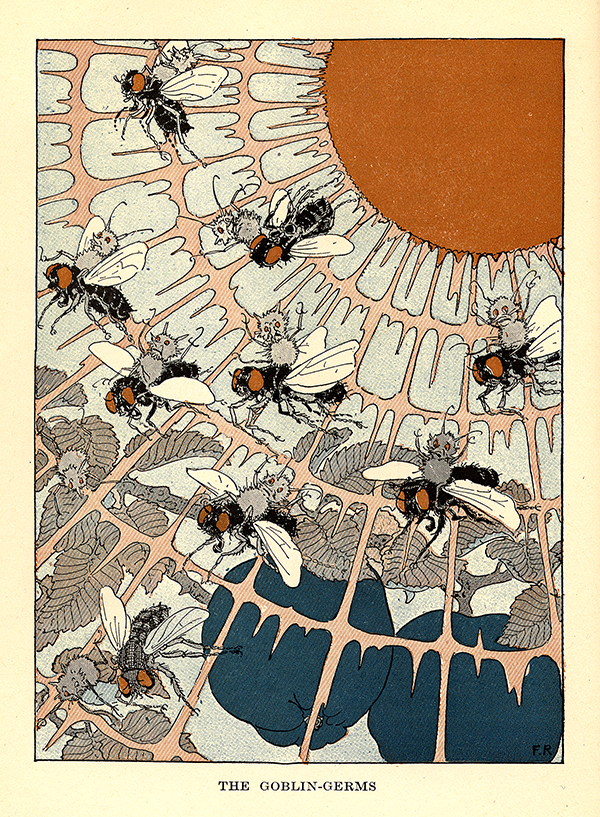
"The Goblin-Germs" Illustration from Jack O'Health and Peg O'Joy: A Fairy Tale (1921)
You don’t know me, but please trust me when I tell you that I’m an anxious person, and yet, I’m obsessed with horror. One reason being is how the genre offers an idea about how evil cannot be conquered, but instead, it can only be delayed. Look, yes, it’s a very grim perspective. Except it's a thought I revisit whenever I’m reading about influenza. Think about it like this, annually the virus wreaks havoc. While a virus is not inherently evil, it can be delayed.
Preventive medicine is the idea that by a person manipulating their surroundings or changing their daily habits, they can avoid catching an infectious disease. Studies show that by following through with various tactics, one can limit the progression of a disease at any stage.1 This ranges from not smoking to prevent lung cancer to wearing that mask to prevent the spread of respiratory droplets as seen with COVID-19.2
There are so many familiar beats throughout history. Moments that almost feel like deja vu to the point, I feel as if I’m living in a sequel or maybe even a reboot of the 1918 Flu Pandemic. As with everything, it’s more than just a pandemic story. With anything, it’s one of many layers, full to the brim of panic and one where preventive medicine became a key character because like in our present, there was no immunization to act as preventive medicine.
1918 Flu Pandemic
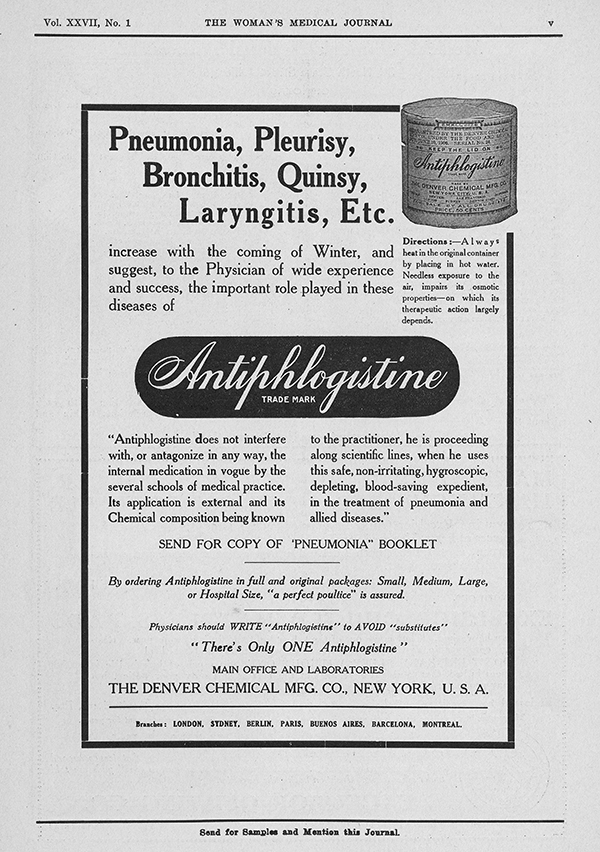
Advertisement published in Woman's Medical Journal (January 1917)
Influenza slithered its way into people’s lives. In the United States, it started out small at Camp Funston in Fort Riley, Kansas. The first flu-like illness was detected in March 1918, and soon after the first case, more than 100 soldiers fell ill.3 The illness spread without gaining a lot of attention though because the flu is a usual suspect. Not to mention, soldiers being sick? They already battled an array of seemingly worse epidemic illnesses such as meningitis.4
As cases increased, physicians became dumbfounded because patients kept arriving with an array of symptoms. The main symptom causing confusion was how influenza patients experienced respiratory symptoms similar to pneumonia, which in 1918, was often fatal.5 Physicians kept misdiagnosing patients by writing off cases as pneumonia. But the unusual kept on happening as influenza cases increased, younger patients were losing their lives, which was anything but usual.6
At the time, preventive medicine started gaining international attention in the medical community with immunization being the ideal approach to preventive medicine, but there wasn’t a flu vaccine. The pandemic was quick to spawn desperation. There was little physicians could do, forcing people to watch in horror as their immune system turned against them with little to no knowledge on how to prevent or delay the illness.7 A flu patient’s immune system tore apart the lungs.8 Patients arrived with pockets of air leaking from ruptured lungs.9
One physician described this occurrence as “emphysema." Meanwhile, a navy nurse reported in horror about how patients’ breathing sounded like a bowl of Rice Krispies.10 This was not ok, none of this was ok. To make matters worse, a considerable number of influenza patients experienced epistaxis, which is the hemorrhaging of mucous membranes resulting in dramatic nose bleeds.11
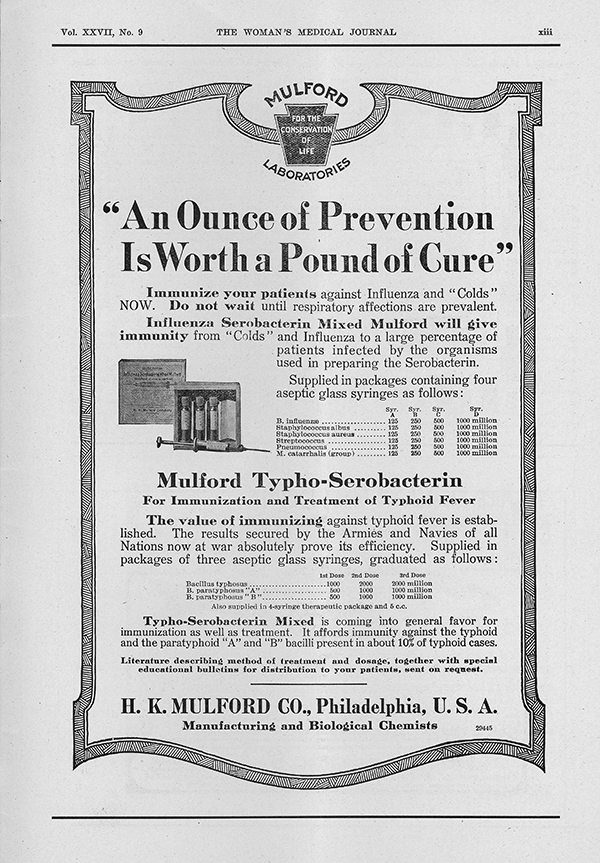
Advertisement for Typhoid Fever from Mulford Laboratories, a Philadelphia pharmaceutical company, in Woman's Medical Journal (September 1917)
In a desperate attempt to flatten the curve of flu cases, some physicians hoped using a different vaccine would help boost an individual’s immune system. Therefore, the typhoid vaccine was used with this hope in mind, but there was little understanding of how the immune system worked at the time. The immune system did not need a boost because it was the problem.12
During the 1918 Flu Pandemic, people died due to a “cytokine storm", which is a term coined by modern researchers to describe the lethal measures the immune system takes to fight a virus. In other words, once influenza entered a person’s lungs, the immune system waged a battle against the virus. A person’s immune system changes with age; during their young adult years, it's at its strongest.
Woman’s Medical College of Pennsylvania
World War I took its toll on the Woman’s Medical College of Pennsylvania (WMCP), it split their staff up across Europe from France to Serbia.14 Due to the success of women practicing medicine overseas, there was an increase in positions for women in the medical field meaning WMCP needed to remain open with new opportunities. More medical schools were admitting women, internships options increased, and there was even a call for more female ambulance drivers.15
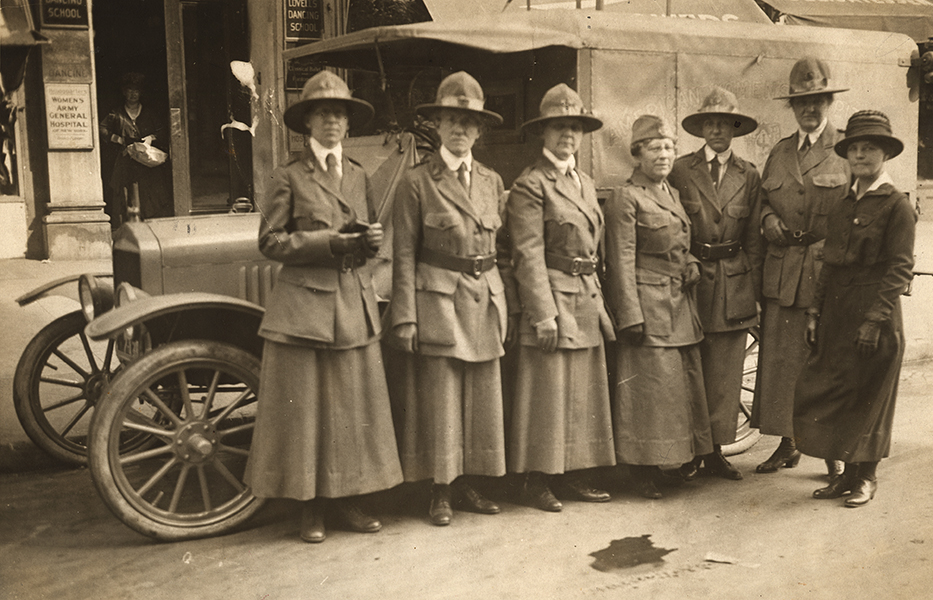
American Women's Hospitals Services Doctors and Nurses in New York City (approximately 1918).
WMCP’s dean, Dr. Martha Tracy, observed this increased demand for female physicians believing by 1918 that 2,000 women could be placed annually within the medical field to work at increased demand for female physicians at colleges, hospitals, laboratories. She believed the growth of preventive medicine practice would continue to offer additional career paths for women in medicine. Therefore, WMCP established courses and a department focused on preventive medicine highlighting it as a prime opportunity to welcome even more women into the field.16 Dr. Tracy insisted:
Let us women physicians, by all means, use our opportunities and our influence to interest and recruit the young college women of the country for this medical service.17
Prior to 1918, freshmen classes entering WMCP saw a steady increase, its newest class grew by a third compared to previous classes.18 Although to simplify the matter, 1918 was no ordinary year for those students. Woman’s Medical College of Philadelphia welcomed their new freshmen class and returning students in a world that feared a new plague was haunting them.
First Contact with the Virus
The first influenza case was admitted to the college hospital at the Woman’s Medical College of Pennsylvania on September 18, 1918. Another case was quick to follow on September 21, 1918.19 Influenza cases were relentless, within the next six weeks the hospital saw about 50 cases of the flu, which then led to overflow by October. Hospital staff soon started to fall ill with the flu, as well.20 With staff catching the flu, the college hospital faced a severe problem. They didn’t have enough people to care for their community because WWI already caused a shortage of physicians, and now the physicians left behind are losing their lives on a new homefront in the United States.
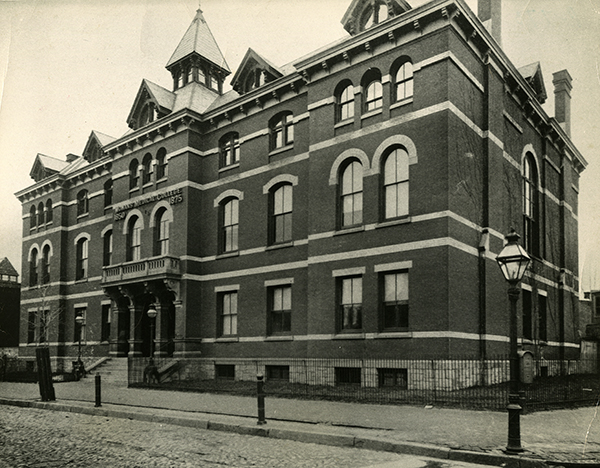
Woman's Medical College of Pennsylvania (1920)(approximately 1918).
The instant rise in influenza cases forced WMCP’s classes to come to a halt. For about three weeks, classes were canceled while faculty figured out how to commit to the following academic year while also supporting the flu crisis at hand.21
Due to a shortage of hospital staff, students rose up to work in their place as nurses or interns to better support the front line staff of hospitals.22 Since the freshman class experienced little training, they focused on making sure the college continued to run while also providing relief for those working on the front lines.23
As overflow continued to serve as a problem, the college’s gymnasium was soon fitted as an emergency ward. Except even then, it wasn’t enough as cases continued increasing and the hospital in turn continued to expand into different spaces on the college campus.24 Influenza became one of two focuses. Even surgical procedures were postponed until further notice.25
Keep in mind, this hospital was one of dozens in Philadelphia. In fact, the college hospital physically shared space on the same block as the Woman’s Hospital of Philadelphia in 1918. All facilities faced overflow, which meant no matter how much space the WMCP converted, it was never going to be enough.26 The odds were in nobody’s favor.
A Different Solution
The world was still in shock as younger flu patients continued to die. In previous epidemics, the flu only seemed dangerous to infants, the elderly, those in the military, and was often connected to miscarriages and the death of pregnant people.27 Such a fear dated back to the 1500s, and the fear was grounded in reality. Pregnant individuals were highly susceptible to influenza, and those who survived often lost their children. Throughout the 1918 Pandemic, the going death rate for pregnant individuals ranged from 23-71%.28
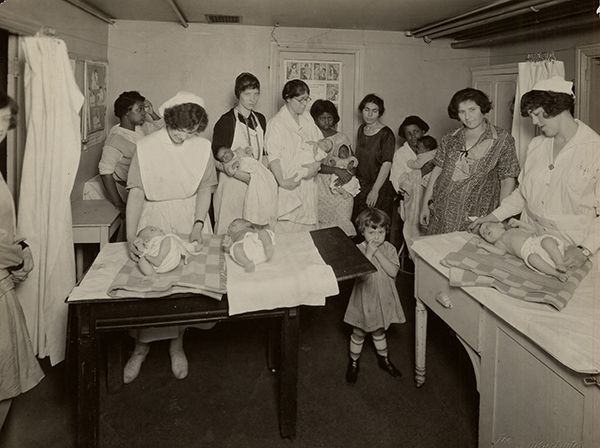
Caring for Children (1918)
And while the hospital at WMCP converted its space to intake more flu patients, they needed to ask: What about all the pregnant patients? How could the hospital best serve them? If one pregnant flu patient was admitted to the ward, it would be devastating. WMCP's hospital is one example. Nearby, the overflow of patients forced staff at the West Philadelphia Hospital for Women to use bathtubs as cribs for infants. The majority of their space was converted to support only flu patients.29
Therefore, WMCP staff concluded: If a pregnant patient experienced flu-like symptoms was admitted, they were not admitted to the Maternity Ward but instead to the Medical Ward with the rest of the flu patients. The hospital refused to turn away a patient in need, which meant a balance needed to be created to best support everybody.30
WMCP’s efforts worked in their favor even with the Maternity Department seeing an increase in cases at the start of the flu epidemic. Throughout the 1918-1919 period, 224 babies were delivered, which included 8 pairs of twins. To support additional preventive medicine efforts, the Maternity Department educated new mothers on feeding their infants and general hygiene.31 The Maternity Department did not lose one case to the flu or pneumonia.32
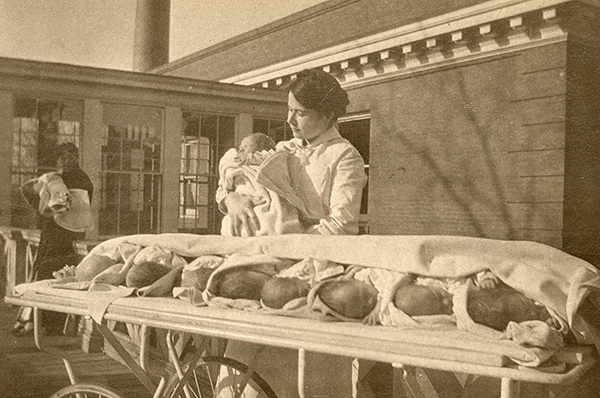
Dr. Florence Weaver at Woman's Medical College of Pennsylvania Hospital (1918)
Meanwhile, the admitted pregnant patients with flu symptoms faced more complications especially during the puerperium period, which is the period after delivery. About seventeen women struggled through this period due to influenza after effects, and out of those cases, seven women lost their lives.33
Relearning Epidemics
The lessons learned in the former epidemic, which only a few of us remember, have to be relearned in this.34
Elizabeth L. Peck spoke at the WMCP's 1919 Annual Alumnae Association Meeting in the aftermath of the flu pandemic. Her haunting words above focus on the idea of tackling influenza treatment because 1918 was not the first time the United States saw the flu cause an epidemic.
Prior to 1918, about 20 years earlier the US battled a flu epidemic from 1889-1890. And yet, even with physicians who lived and worked during the prior epidemic, their information was not passed down forcing people to relearn the process of facing an epidemic. Therefore, Dr. Peck's sought to highlight the importance of preventive medicine. If physicians could not conquer influenza, then a practice needed to be put into place to delay influenza from taking such an apocalyptic grip on society. The practice of preventive medicine needed to explore different avenues beyond only relying on immunization to save lives.
The pandemic met its end in 1919, but it wasn't until the 1930s when researchers isolated influenza allowing them to define it as a virus that turned an individual's immune system into a fatal enemy. The first flu vaccine followed in 1942. About 20+ years after the 1918 flu pandemic, physicians found their "magic bullet."35
Dr. Peck and the Woman's Medical College of Pennsylvania understood the importance of upholding preventive medicine practice and research.36 With no sight of a vaccine in the near future, they chose to focus on looking at how to improve the practice since it sought to help people understand how to manipulate their surroundings or change their daily habits to avoid catching an infectious disease. While a handful of good ideas took root during the pandemic, further research needed to happen to better define proper hygiene tactics or how to best wear a mask to prevent the spread of respiratory droplets in order to save lives.37
Interested in learning more
Works Cited
1E. A. Clarke. “What is Preventive Medicine. Can Fam Physician, Vol. 20, No. 11 (November 1974), 65.
2Erin Welsh and Erin Allman Updyke, hosts. “Covid-19 Ch 3: Control” (Podcast), March 23, 2020.
3“1918 Pandemic Timeline.” Centers for Disease Control and Prevention (March 2018).
4John M. Barry. The Great Influenza: The Story of the Deadliest Pandemic in History. (New York City, NY: Penguin Books, 2004), 146 and 283-284.
5Barry, 238 and 242-243.
6Barry, 234
7Barry, 553
8Barry, 246-247.
9Barry, 234
10Barry, 235
11Barry, 237
12Barry, 253
13Barry, 249-250 and 530.
14George Morris Piersol. “Delivered at the Opening of the Seventieth Session of the Woman’s Medical College of Pennsylvania, October 1, 1919.” Bulletin of the Woman’s Medical College of Pennsylvania, September 1919 (1919), 5.
15“Demand for More Women Physicians in the Army.” Woman’s Medical Journal, Vol. 27, No. 1 (January 1917), 17 and “Report on Internships for Women.” Woman’s Medical Journal, Vol. 27, No. 2 (February 1917), 42 and 37-42.
16Martha Tracy “Report of the Woman’s Medical College of Pennsylvania.” Transactions of the Forty-Third Annual Meeting of the Alumnae Association of the Woman’s Medical College of Pennsylvania, June 6 and 7, 1918 (1918), 57-65 and Martha Tracy. “A Campaign of Propaganda for Recruits to Medical Colleges.” Census of Women Physicians, November 11, 1918 (The American Women’s Hospitals: 1918), 6.
17Tracy, 6.
18Martha Tracy. “A Campaign of Propaganda for New Recruits to Medical Colleges,” 6.
19Tracy, 6.
20Anne H. Thomas. “Clinical Aspects.” Transactions of the Forty-Fourth Annual Meeting of the Alumnae Association of the Woman’s Medical College of Pennsylvania, June 19 and 20, 1919 (1919), 68-76.
21
Thomas
, 68-69 and Martha Tracy. “Report of the Woman’s Medical College of Pennsylvania,” 57-65
22“News Notes.” Bulletin of the Woman’s Medical College of Pennsylvania (December 1918), 18.
23Tracy, 57-65
24“News Notes,” 18.
25“Report of the Medical Director.” Hospital of the Woman’s Medical College of Pennsylvania, 19.
26Florence E. Kraker. “Report of the Maternity Department.” Hospital of Woman’s Medical College of Pennsylvania, 25.
27“The Gymnasium in Epidemic Days.” Bulletin of the Woman’s Medical College of Pennsylvania (December 1918), 23-24 and “The Woman’s Hospital.” Bulletin of the Woman’s Medical College of Pennsylvania (December 1918), 24.
28Barry, 219
29Barry, 240
30Mary R. Hadley Lewis. “Report of the Medical Director, 1918-1919.” West Philadelphia Hospital for Women (1919), 14-15 and Kraker, 25.
31Lewis, 14-15.
32Kraker, 25.
33“Report of the Medical Director,” 19.
34Lewis, 14-15.
35Elizabeth L. Peck. “Treatment.” Transactions of the Forty-Fourth Annual Meeting of Alumnae Association of the Woman’s Medical College of Pennsylvania, June 19 and 20, 1919 (1919), 77-78; Claude Hannoun. “The Evolving History of Influenza Viruses and Influenza Vaccines.” Expert Reviews Vaccines, Vol. 12, No. 9 (2013), 1085-1094 and Barry, 265.
36Peck, 77-78.
37“The 1918 Flu Pandemic: Why It Matters 100 Years Later.” Center for Disease Control and Prevention (May 2018).